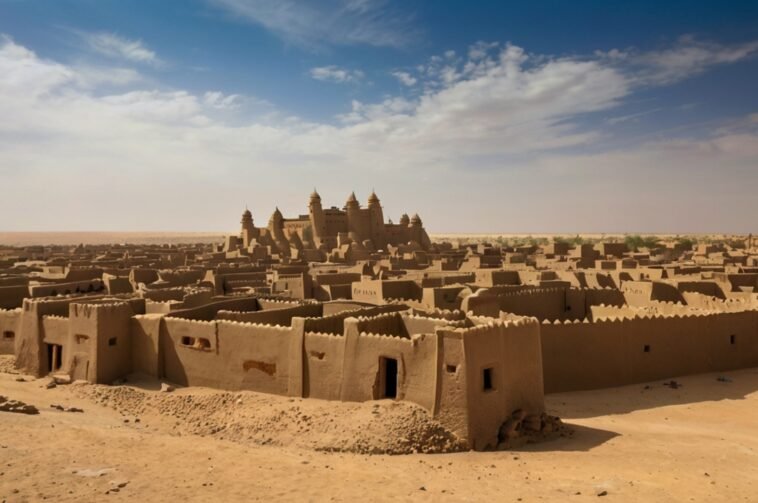
Timbuktu—a name that evokes mystery and adventure.
For centuries, it was considered a lost city, hidden deep in the sands of the Sahara.
However, Timbuktu was once a thriving center of trade, learning, and culture, often referred to as the “Athens of Africa.”
During its golden age, it was home to scholars, vast libraries, and one of the most important universities in the medieval world.
But how did this city rise to such prominence, and why did it eventually decline?
Let’s explore the fascinating history of Timbuktu.
Timbuktu: A Center of Trade and Culture
Location and trade
Timbuktu is located in present-day Mali, near the Niger River.
Its strategic location made it a key trading hub connecting North Africa, West Africa, and the Middle East.
Traders traveled across the Sahara with caravans of camels, carrying salt, gold, ivory, and slaves.
Salt, in particular, was a highly valued commodity, often called “white gold.”
At its peak in the 14th and 15th centuries, Timbuktu was a bustling metropolis with merchants from as far away as Egypt, Morocco, and the Ottoman Empire.
According to historian John Hunwick (1999), the city’s population reached between 50,000 and 100,000 people, making it one of the largest cities in the medieval world.
How Trade Fostered Culture
Trade brought wealth and opportunity, which helped create a vibrant cultural and intellectual community.
Wealthy merchants and leaders supported education and the arts, building mosques, universities, and libraries.
The blending of African, Arab, and Berber traditions created a unique and dynamic environment where ideas and knowledge flourished.
This cultural exchange made the region a thriving center of learning and creativity.
Growth of the city
Timbuktu’s growth was largely driven by the Mali Empire, particularly under the rule of Mansa Musa (1312–1337), one of the wealthiest individuals in history.
During his famous pilgrimage to Mecca in 1324, he distributed so much gold that he caused inflation in Cairo.
Upon his return, he invested heavily in Timbuktu, attracting scholars, architects, and artists from across the Islamic world.
The city continued to grow under the Songhai Empire (15th–16th centuries), becoming a beacon of learning and a center for Islamic scholarship.

The Golden Age of Learning
Rise of Islamic scholarship
By the 1400s, Timbuktu had become famous for its scholars and intellectual contributions.
Islamic scholars from Africa and the Middle East traveled to the city to teach, learn, and exchange ideas.
This made Timbuktu a central hub for religious, scientific, and philosophical knowledge, solidifying its reputation as a beacon of learning and culture.
The University of Sankore
The most famous educational institution in Timbuktu was the University of Sankore.
Established in the 14th century, it became one of the greatest centers of learning in the Islamic world.
Some estimates suggest it housed up to 25,000 students at its peak.
The curriculum covered a wide range of subjects, including theology, astronomy, medicine, mathematics, and law.
Unlike European universities of the time, Sankore followed a decentralized system where scholars taught students in their own homes or mosques.
The famous libraries
Timbuktu’s libraries were among the most impressive in the medieval world.
Manuscripts covered various fields, including astronomy, history, poetry, and medicine.
Some sources suggest that the city housed over 700,000 manuscripts (Jeppie & Diagne, 2008).
Even today, thousands of ancient manuscripts remain preserved in private collections and institutions like the Ahmed Baba Institute, which was established to protect and study these historical texts.
Scholars and writers
Several prominent scholars and writers emerged from Timbuktu, including:
- Ahmed Baba (1556–1627) – A leading Islamic scholar and historian, often called “the last great scholar of Timbuktu.”
- Muhammad Bagayogo – A prominent jurist and theologian who contributed to Islamic jurisprudence.
- Mahmud Kati – The author of The Tarikh al-Fattash, an important historical chronicle of West Africa.

The Decline and Rediscovery
Factors leading to decline
Timbuktu’s decline began in the late 16th century when the Moroccan army invaded in 1591. The city was plundered, and many scholars were exiled or executed.
Over the following centuries, shifting trade routes and European colonial expansion further reduced Timbuktu’s importance.
By the 19th century, European explorers and writers portrayed Timbuktu as a mythical “lost city,” exaggerating its remoteness and mystery.
The “Lost City” myth
Although Timbuktu declined over time, it was never truly lost.
European fascination with Africa’s unexplored regions created stories of a hidden city overflowing with gold.
Explorers like René Caillié (1828) and Heinrich Barth (1853) eventually reached Timbuktu, dispelling some of these myths.
Instead of finding a city of gold, they discovered a place with a deep and rich history, rooted in culture and knowledge.
Modern rediscovery and preservation
Today, people are working hard to protect Timbuktu’s historical sites and ancient manuscripts.
Organizations like UNESCO and the Timbuktu Manuscripts Project are leading efforts to safeguard the city’s cultural heritage.
However, challenges like political instability and the risk of damage by extremist groups continue to threaten these efforts.
Despite these obstacles, preserving Timbuktu’s legacy remains a priority, ensuring its story continues to inspire future generations.

Final Thoughts
Timbuktu’s role as a hub of knowledge and culture is a powerful part of history.
Though its golden age is behind us, the city’s impact still resonates today.
Its ancient manuscripts, stunning mosques, and enduring stories highlight Africa’s profound intellectual and cultural contributions to the world.
Timbuktu reminds us of the rich heritage that continues to inspire and educate people across the globe.



